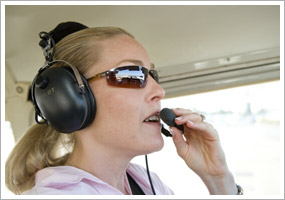
The following stories from the August 15, 2008, edition of AOPA ePilot were provided to AOPA members who expressed an interest in the particular subject areas. Any AOPA member can receive information tailored to their areas of interest by updating their preferences online.
| My ePilot Training Tips |
| 'ACKNOWLEDGE!' The specific meaning of "acknowledge," given in the " Pilot/Controller Glossary" in the Aeronautical Information Manual (AIM), is "Let me know that you have received my message." That's always key to clear communications. So if a controller specifically requests that you "acknowledge," give an immediate, positive response. "When talking to a controller, the general rule is that you must fully acknowledge all commands. Climbs, descents, turns, and clearances must be repeated so that the controller knows that you received the proper information. Acknowledging a descent clearance with just your call sign is not acceptable and can incur the wrath of the controllers, especially if they are busy and have to waste time getting you to do your job. Likewise, acknowledging a command without using your call sign is also a no-no, because the controller doesn't know which aircraft took the command," Chip Wright said in the May 2005 AOPA Flight Training feature " Talking the Talk." "On the ground, the most critical—but by no means the only—items to read back are hold-short commands, and it doesn't matter if the hold-short command is for a runway or a taxiway. If you don't properly read back the hold-short command, the controller is required to bug you until you do." Acknowledging instructions is not the same as a "readback," in which you repeat the entire message to the controller, such as when receiving taxi instructions. The AIM explains: "When taxi instructions are received from the controller, pilots should always read back: (a) The runway assignment. Controllers are required to request a readback of runway hold short assignment when it is not received from the pilot/vehicle." These and other terms used by ATC are discussed in the " New Pilot's Guide to ATC Communications" article on AOPA Flight Training Online. Make it your mission to know how to respond. Help another student save! |
| Training Products |
| FREE DOWNLOAD OF FAA'S 'BALLOON FLYING HANDBOOK' Note: Products listed have not been evaluated by ePilot editors unless otherwise noted. AOPA assumes no responsibility for products or services listed or for claims or actions by manufacturers or vendors. |
| My ePilot Final Exam |
| Question: This time of year thunderstorms are common. Can you tell me about some of their characteristics? Answer: Thunderstorms need sufficient moisture, unstable air, and lifting action to form. They have three stages: towering cumulus, mature, and dissipating. In the towering cumulus stage, water vapor is lifted by updrafts and condenses to form a cumulus cloud. Falling rain and downdrafts indicate the mature stage of a thunderstorm. Finally, a storm dissipates as the air below the cloud cools and cuts off the supply of warm, humid air. The anvil shape of some thunderstorm clouds is easily seen, but storms can also be embedded in haze or large cloudbanks, which make them difficult to spot. Put at least 20 nm between you and the storm when flying around isolated storms. When faced with a line of convective activity, landing and waiting for the weather to pass is usually the best choice. Learn more about thunderstorms by taking the AOPA Air Safety Foundation's online course, Weather Wise: Thunderstorms and ATC .Got a question for our technical services staff? E-mail to [email protected] or call the Pilot Information Center, 800/872-2672. Don't forget the online archive of "Final Exam" questions and answers, searchable by keyword or topic. |
 Sometimes in busy airspace or on the ground at a bustling airport, you'll hear a controller fire off instructions followed by a command such as, "Hold short, 'acknowledge' hold." Why was "acknowledge" added to the transmission? What should the acknowledging pilot say?
Sometimes in busy airspace or on the ground at a bustling airport, you'll hear a controller fire off instructions followed by a command such as, "Hold short, 'acknowledge' hold." Why was "acknowledge" added to the transmission? What should the acknowledging pilot say?

